You may not find this terribly rewarding unless you're included here, so this is a good time for casual and random browsers to turn back before they get too caught up in the sweep and majesty of the proceedings and can't let go.
Hunting scenic waterfalls in the wilds of Kentucky

We begin our adventure on the morning of 4 October 2021 in Kokomo, Indiana, in a very worthy La Quinta Inn, with Choupette persistently growling in cat talk 'Hurry up and load the car, let's get this show on the road'.

Which we did, five hours southward, down I75 past Lexington, past Pittsburg (no 'h') to Corbin, Kentucky (pop. 7,000 in town, but connected in various overlapping jurisdictions in three counties to form a larger 'urban cluster' of 21,000, worth taking the trouble to collect taxes from). Corbin is described as 'a city progressive in spirit, yet traditional at heart' (we're not sure what that means).
Our target, and refuge for the next few days, is the Cumberland Falls State Resort Park (and it's DuPont Lodge, seen here), which is officially in Corbin but is actually hidden some 14 miles (22km) to the southwest in some seriously wild, underinhabited countryside.

Kentucky has 45 state parks, of which 17 are State Resort Parks, that is, fitted out with a lodge, cabins, and campgrounds, scenic raisons d'être, restaurant and (in some) a pub, free wifi, and a lot of sporting opportunities. We've visited the Carter Caves and the Natural Bridge resorts over the past year, and we're becoming fans. This and the others we've seen so far have been built by the Depression-era Civilian Conservation Corps of the 1930s.

We're unpacking, and the cats are decompressing. Melvin is just meditating again, but Choupette seems reluctant to trust leaving the cat-carrier.

Melvin takes advantage of Choupette's stupor and occupies the catnip saucer, the preferred roost for all cats.

But Choupette is certainly not going to stand for that, so the inevitable minor drama plays out and Melvin goes back to his meditations.
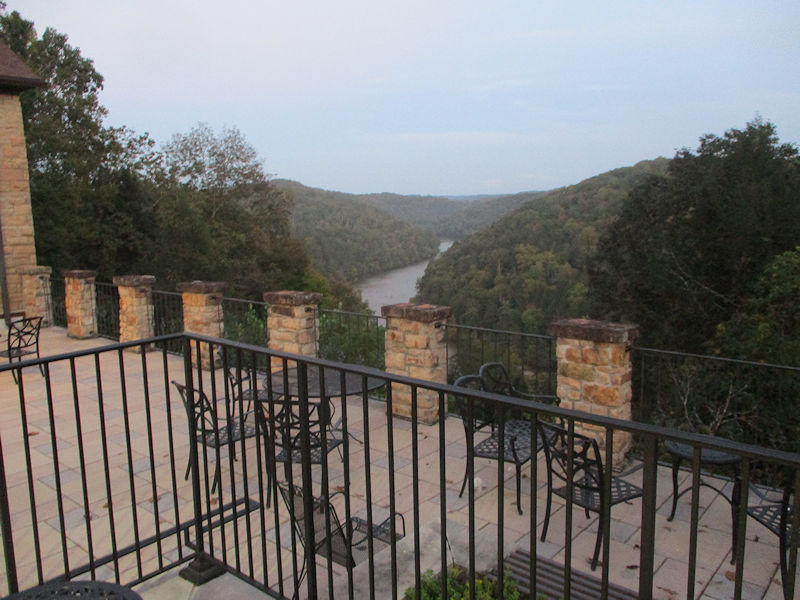
The restaurants in these resorts are basic but certainly acceptable, but this one (we've just learnt) is just take-out (insufficient staff, of course). So we're dining up on the patio on the roof, and in any case we've happened to bring along a fair amount of chili from Culver's for the microwave in the reception area.
Potentially more sobering, however, is the news that we are dining in what's quaintly called a 'dry county' -- a term that we haven't heard since the ratification of the 21st Amendment to the Constitution, repealing Prohibution, in 1933. That explains the absence of a pub here, but in fact, we're pretty well supplied in that regard as well.

That's an upstream hunk of the Cumberland River, a 688-mile (1,100km) serpent wriggling towards us here from sources in the Appalachian mountains, flowing northward over the eponymous Falls below us to the right, then going west and then south into Tennessee (probably reluctantly) for quite a ways, then back north into Kentucky, and ending in 'Paducah' (which is said to be on the Ohio River.)

Our chili containers have been disposed of appropriately, and before retiring to our room to strengthen ourselves for tomorrow's venture to the Falls, we're on a scoping mission of the facilities. They're dated, but with their own sort of CCC elegance.

One of the amenities on offer is the possibility of a grasshopper in the room, providing amusement for any pets you might have brought along.

But for Choupette, insects are not just benign amusements; they need to be dealt with, sternly.

The next morning, 5 October, we descend into the restaurant, which manages the slender breakfast trade with a free array of store-bought, prepackaged things to eat, mostly very sweet -- mostly repugnant, to be honest, but perhaps appropriate before a major hike -- and at least there's real coffee.

Seeking a little trail information from the reception desk. What staff they have here, by the way, are all very friendly and helpful.

So we're off, on a grey and possibly threatening day, bound for the short trail straight down to the Falls and the Visitors Centre.

'Wait there for us; we'll be back.'
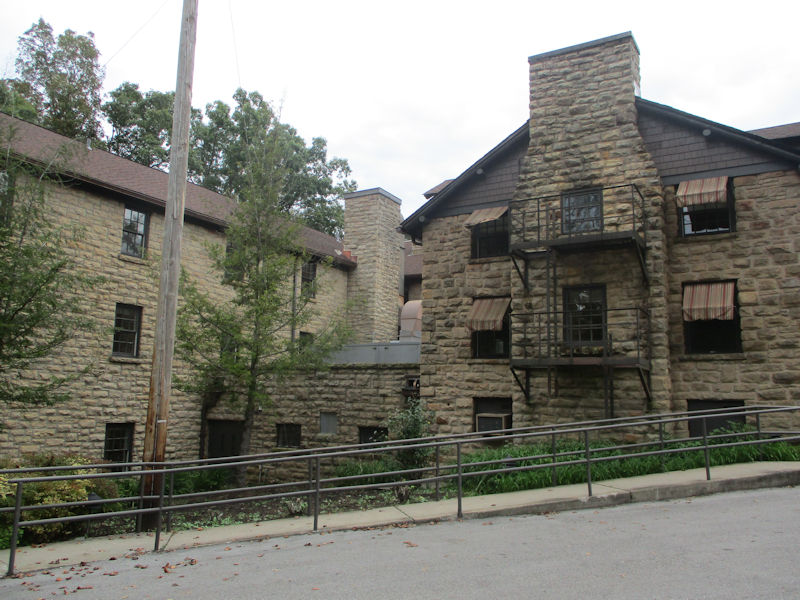
Our room is somewhere on the far side of that left wing, overlooking the river.

The trail is well-prepared (probably thanks to the CCC 'boys'), but you have to bring your own parachute.

They grow their rocks big round here.

We're sliding down amongst some huge craggy cliffs -- this DuPont Lodge seems to have been built out on an impregnable promontory of cliffs.

We're actually traversing under a line of cliffs topped by campgrounds and carparks.


Now we're turning back towards the river, and doing a little downhill as we proceed.

Now we're on top of a cliffy thing instead. Don't look down.

Or do look down -- that's the fabled Edward Moss Gatliff Bridge over the Cumberland River.


A little bit of downness, but not much

'Down' is getting more serious now.
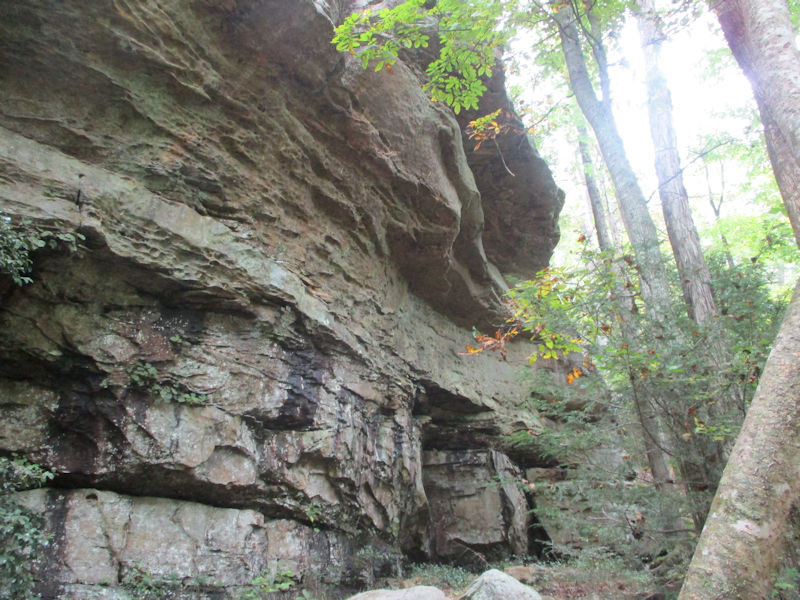

Below us, the lower part of Rte 90, the access road into the wilderness after you've forsaken I75 for US Rte 25W, and kept your eyes peeled back for the turnoff.

Just above the river, now the last few meters towards the Visitors Centre

We're accompanying the river for a ways, along flat conglomerate shelves that are vying to become the next Cumberland Falls.
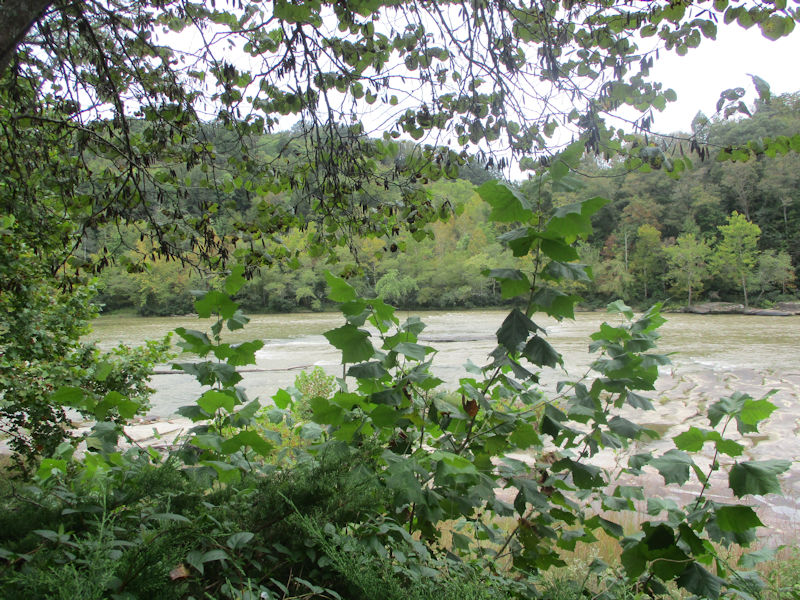
Nearly there; patience

The Visitors Centre -- the gift shop is open, some of the other amenities, like the snack bar, are not. Fine big flag there.

Educational experiences along the path to the Falls


Here we are . . .

. . . it's not the Niagara Horseshoe Falls, but it's certainly vigorous, and loud.
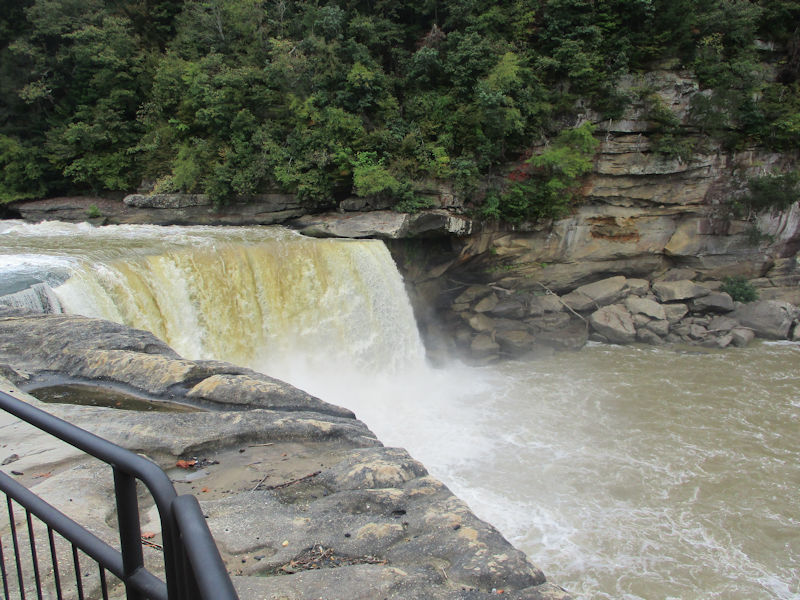
Sixty-eight feet high, we're told, and 125 feet across -- according to Wikipedia, 'Cumberland Falls is the second largest waterfall east of the Rocky Mountains, and the largest waterfall as measured by water volume in the Eastern United States, south of Niagara Falls.' (As impressive as that is, that does seem a little bit doubtful. Be that as it may, this is referred to as 'the Niagara of the South'.)

The downriver (northward) look -- the view from the top of those cliffs should be marvelous. (We'll soon find out, as it happens.)
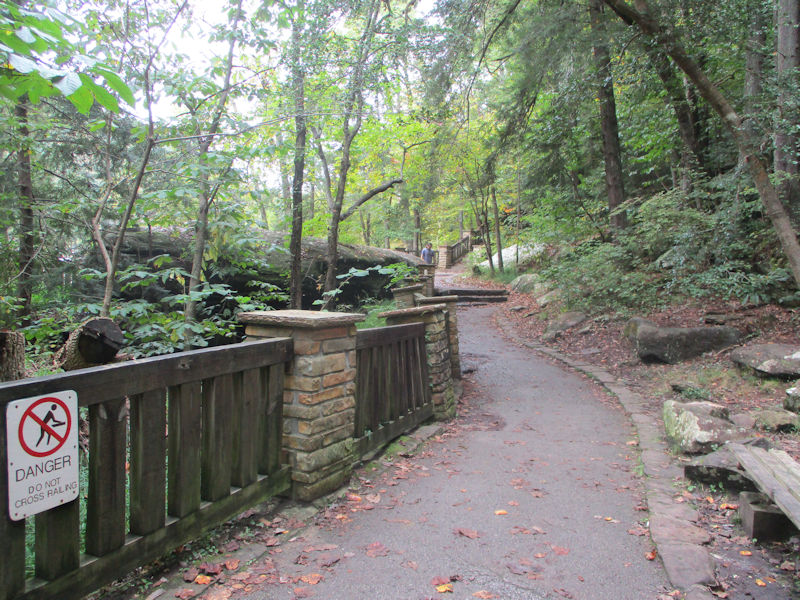
We're following along for some further viewing points. There's no charge, by the way, for viewing the Falls and walking all round here, and galloping along on the several hiking trails, though the lodge, cabins, and campgrounds do have reasonable fees.


The Falls seen from lower down and a bit farther along the river
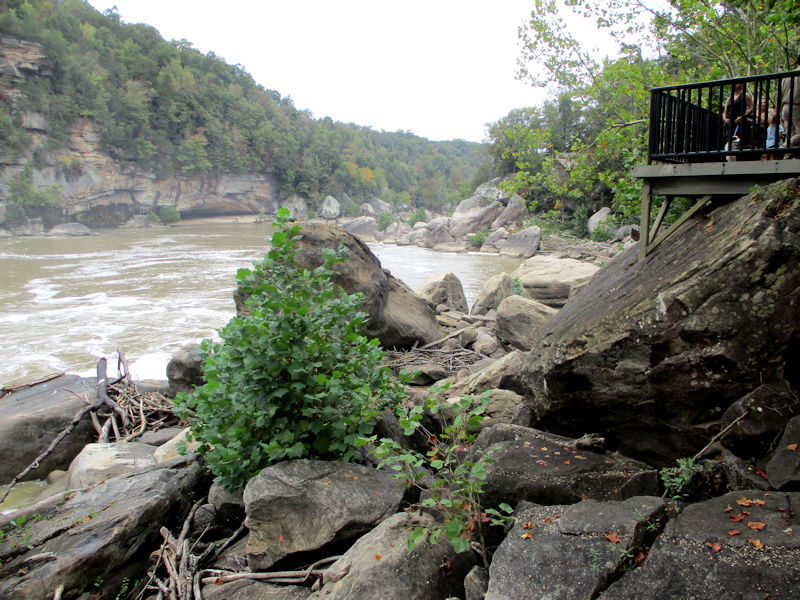
Bouldery collections of geological leftovers
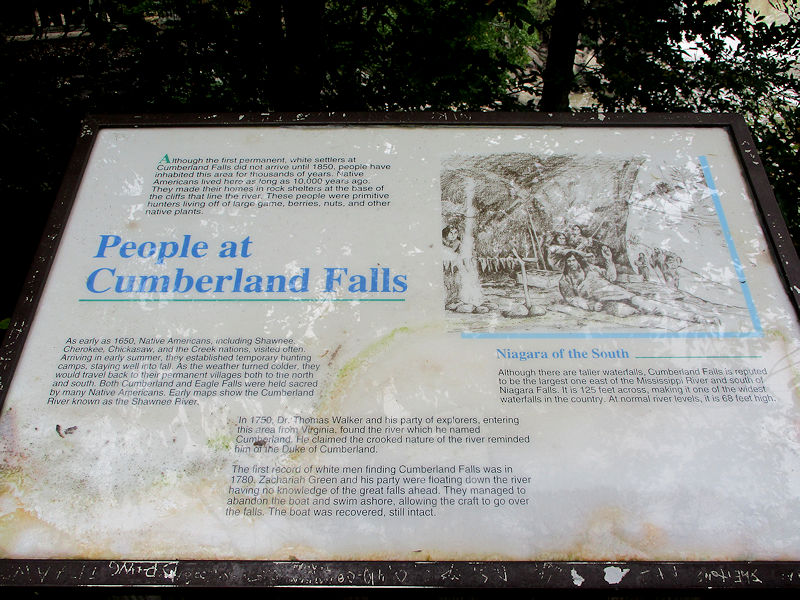
Some of the pre-European inhabitants of the area are described on one of the several information plaques planted about the walkways.

Again, from farther downstream. The Falls had been mentioned by hardy travelers as early as the mid-late 1700s, and the place was purchased by two Revolutionary War vets in 1800. The first permanent settlers arrived in 1850, and in 1875 a certain Socrates Owens bought the land and built the Cumberland Hotel, which soon became a popular summer destination for tourists -- early guests reached the hotel via a railway stop 12 miles to the west and continued by mule 'joltwagons' for four hours of torment to the hotel.

The Brunson family operated the hotel from 1902 to 1931, but in efforts to prevent the construction of a power station on the river, local conservationists convinced members of the wealthy du Pont family to buy the area and forbid hydroelectric damming. In 1930 the family donated over 500 acres with the Falls to the state, and the Kentucky legislatures accepted the gift, overriding the veto of the Republican governor, known as Flem D. Sampson. It was opened as Kentucky's third state park in 1931.

We continue along the viewing trail . . .

. . . secure in the expectation that if those huge teetery monoliths have got through so many years of people hammering in walkways all round them, they'll likely stay put a little while longer (we'll only need about 20 minutes).


No lifeguards on duty!
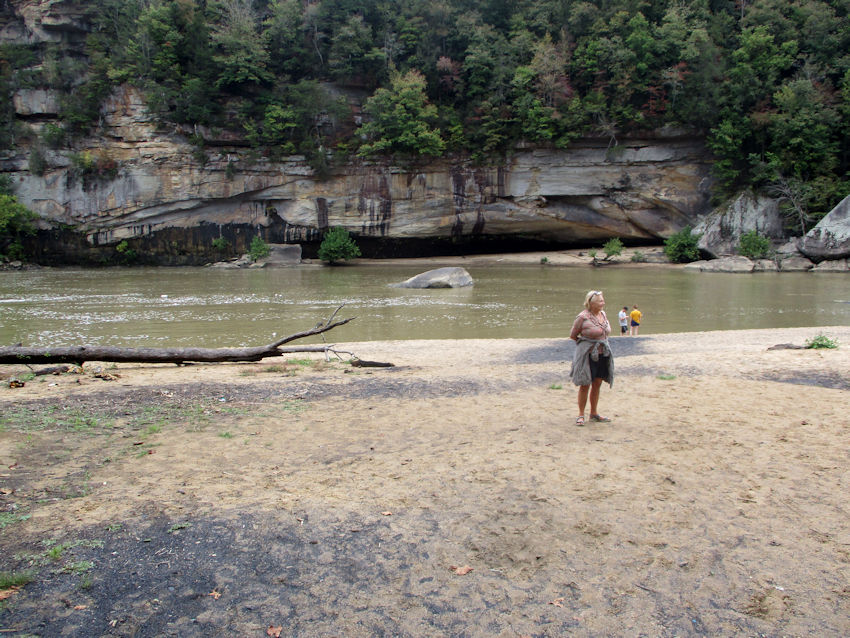
Reflective moments on the Cumberland River

Very relaxing . . . and with only the climb back up to the lodge standing between us and dinner.
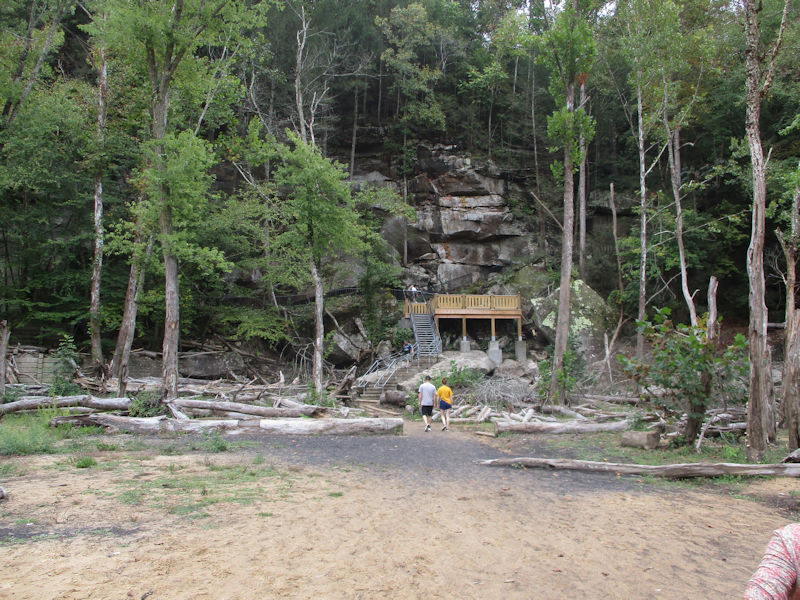
Enough of the reflections, we'll start back for dinner now.

A last waterfall view from this side of the river

What?! Now they tell us.

An October visit -- it's like we nearly have the place to ourselves.

Alley-oop! Wait up.

The Brunsons' old hotel burnt down in the 1940s and was never rebuilt. The DuPont Lodge and 15 cabins were built by the Civilian Conservation Corps in 1933 -- the Lodge too burnt down in 1940 and the present building replaced it in 1941. The paint's peeling a bit here and there, but it all has a satisfactory sort of solid elegance.

The meeting room also serves as a mini-museum for the history of the place and photos, with a special, and well-merited, emphasis on the work of the CCC.

It would be so disheartening to have to watch any recent US administration try to propose such an inspired programme to the Senate and House, as it disappears into some politician's desk drawer until the rats eat it.

Not that we'd be mad keen to spend a lot of time living like this . . . but if we were that desperate, surely we'd be grateful.
 Dwight Peck's personal website
Dwight Peck's personal website



























































